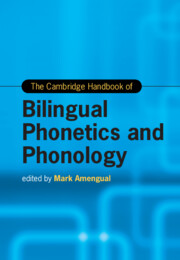Book contents
- The Cambridge Handbook of Bilingual Phonetics and Phonology
- Cambridge Handbooks in Language and Linguistics
- The Cambridge Handbook of Bilingual Phonetics and Phonology
- Copyright page
- Dedication
- Contents
- Figures
- Tables
- Contributors
- Acknowledgments
- Introduction Bilingual Phonetics and Phonology
- Part I Approaches to Bilingual Phonetics and Phonology
- Part II Theoretical Models of Bilingual Phonetics and Phonology
- 7 The Perceptual Assimilation Model: Early Bilingual Adults and Developmental Foundations
- 8 The Second Language Linguistic Perception Model
- 9 The Automatic Selective Perception Model
- 10 The Ontogeny Phylogeny Model
- 11 Bilingual Speech and Exemplar Theory
- Part III The Phonetics and Phonology of the Bilingual Child
- Part IV The Phonetics and Phonology of the Bilingual Adult
- Part V The Diversity of Bilingual Speakers
- Part VI Variables and Outcomes of Bilingual Speech
- Index
- References
9 - The Automatic Selective Perception Model
from Part II - Theoretical Models of Bilingual Phonetics and Phonology
Published online by Cambridge University Press: 14 November 2024
- The Cambridge Handbook of Bilingual Phonetics and Phonology
- Cambridge Handbooks in Language and Linguistics
- The Cambridge Handbook of Bilingual Phonetics and Phonology
- Copyright page
- Dedication
- Contents
- Figures
- Tables
- Contributors
- Acknowledgments
- Introduction Bilingual Phonetics and Phonology
- Part I Approaches to Bilingual Phonetics and Phonology
- Part II Theoretical Models of Bilingual Phonetics and Phonology
- 7 The Perceptual Assimilation Model: Early Bilingual Adults and Developmental Foundations
- 8 The Second Language Linguistic Perception Model
- 9 The Automatic Selective Perception Model
- 10 The Ontogeny Phylogeny Model
- 11 Bilingual Speech and Exemplar Theory
- Part III The Phonetics and Phonology of the Bilingual Child
- Part IV The Phonetics and Phonology of the Bilingual Adult
- Part V The Diversity of Bilingual Speakers
- Part VI Variables and Outcomes of Bilingual Speech
- Index
- References
Summary
The Automatic Selective Perception (ASP) model posits that listeners make use of selective perceptual routines (SPRs) that are fast and efficient for recovering lexical meaning. These SPRs serve as filters to accentuate relevant cues and minimize irrelevant information. Years of experience with the first language (L1) lead to fairly automatic L1 SPRs; consequently, few attentional resources are needed in processing L1 speech. In contrast, L2 SPRs are less automatic. Under difficult task or stimulus conditions, listeners fall back on more automatic processes, specifically L1 SPRs. And L2 speech perception suffers where there is a mismatch between the L1 and the L2 phonetics because L1 SPRs may not extract the important cues needed for identifying L2 phonemes. This chapter will present behavioral and neurophysiology evidence that supports the ASP model, but which also indicates the need for some modification. We offer suggestions for future directions in extending this model.
Keywords
- Type
- Chapter
- Information
- The Cambridge Handbook of Bilingual Phonetics and Phonology , pp. 196 - 216Publisher: Cambridge University PressPrint publication year: 2024
References
- 1
- Cited by

